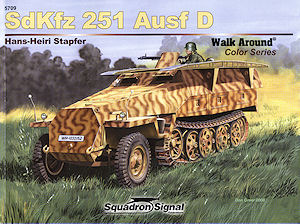 SdKFZ 251 Ausf D
SdKFZ 251 Ausf DWalk Around Color Series #5709
Hans-Heiri Stapfer
Squadron Signal Publications
ISBN 978-0-89747-575-4
80 pages mostly in colour.
Review by Terry AshleyThis is the latest issue in the Squadron Signal Walk Around Color Series and is devoted to the Sd.Kfz.251/7 Ausf.D mittlerer Pionierpanzerwagen and the Sd.Kfz.251/9 Ausf.D 7.5cm mittlerer Schuetzenpanzerwagen, both of which have been restored and are currently located at the Deutsches Panzermuseum (German Armour Museum) at Munster in Northern Germany.
The 80 page soft cover book follows the usual Walk Around formula with all colour photos of the museum vehicles complimented with very brief introductory test covering the development of the 251 and the photo captions that elaborate further with each photo.
The photos range for single full page to three and four per page and so are large enough to clearly show the intended details, with the majority of the book devoted to the Sd.Kfz.251/9 Ausf.D 7.5cm with various close up detailed shots from both vehicles featured.
There are also scrap drawings and side plan drawings as well as a page of colour profiles giving examples of various cam schemes carried on the vehicles.
The plan views are not to any particular scale and would have to be re-scaled if you wanted to use these for any modelling projects and as the plans are not credited to anyone in particular we can assume they are by the author?
The Squadron Signal Walk Around Color Series has always been a useful series for modellers with the good close-up details shots of the type those who like to add that extra to their models are always after.
One of the traps of such books based solely on restored museum vehicles and not just with this series is there are often non genuine parts used during the restoration process and this can mislead if not careful.
I have fallen for this trap in the past and I am sorry to say this book serves as a classic example of what you see is not what you get in that many of the “features” highlighted in the book as examples of the actual 251 series are nothing more than museum additions to arrive at a rebuilt example for display.
That on it’s own wouldn’t be a real problem if explained in the text but unfortunately the author goes to great lengths both in the photos and text to present some of these museum additions as fact.
This lack of understanding or basic research of the subject is grossly misleading for those not familiar with the subject and leads to the many urban myths such as green vision blocks and "Gepard" for the Flakpanzer 38(t) which are so hard the dispel once they get a foot hold.
In particular the numerous photos, text and even plan drawings of the supposed “early” model fenders on the Sd.Kfz.251/9 Ausf.D which are claimed to be genuine but are in fact nothing more than sheet metal fenders added by the museum and don’t even represent the Ausf.C fender profile it is claimed they are.
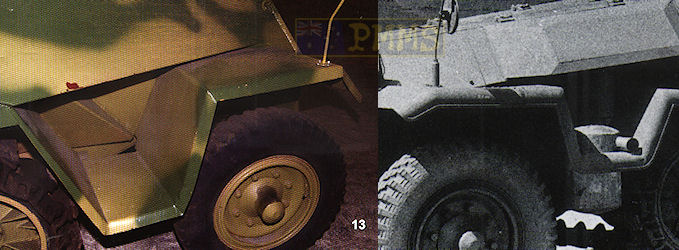
The exhaust muffler used on this reconstituted rebuild is one you will probably find at the local wreckers from a 1972 Ford and is nothing like a WWII German vehicle muffler yet we are told it is an “early” muffler and the lack of forward side storage boxes is also claimed to be an early feature yet again is just sheet metal used to cover over the box location during the rebuild. In one photo caption it is said the front storage boxes were removed as a result of the KwK L/24 gun being fitted, which is incorrect as all 251/9s had the three side storage boxes as per normal 251 Ds.
Note the museum muffler still has the lower brackets for fitting to your car.
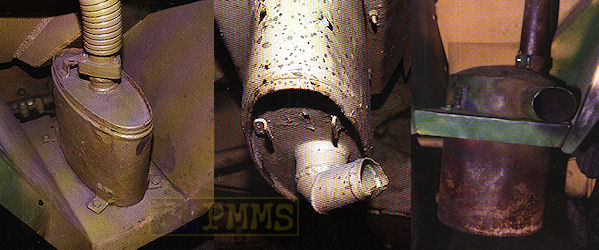
Unfortunately the misinformation doesn’t stop there as the tracks on the museum Sd.Kfz.251/9 Ausf.D have metal plates added over the rubber pads and it is claimed this is another variation on the 251 track. Yet the tracks are actually standard cast Zgw5001/280/140 type track (sometimes referred to as ‘skeletal’ track) to which the museum has added thin metal plates over the pads so they don’t wear out. It’s not like you can go down the local auto parts shop and pick up replacement 251 track pads?
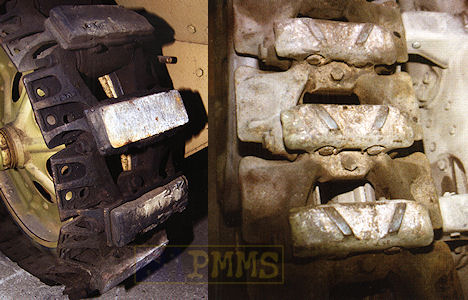
The actual steel cleat track used for about five months from late February to around July 1944 when it was discontinued had the complete metal shoe with two raised cleats and not just a steel plate added over the rubber pad as the book claims.
The real metal tracks created excessive vibrations on paved roads damaging the suspension components and the top speed was limited to 20km/h not the 30km/h as per the text which also claims the “steel shoes often vibrated loose and got lost”, sadly misleading.
Moving to the back entry doors the photos and plans show two simple latches top and bottom of the doors which is again claimed to be an “early” feature of the 251/9 yet again this is just a museum addition when replacing the rear doors and all Ausf.D rear doors had the standard internal rod system with the single central open/close handle.
There are detailed close-ups of bolts holding the door frames in place with different length bolt and it is again claimed these are “uncommon” features, which while partially true because these are replacement bolts used by the museum during restoration and not standard.
With the KwK 37 L/25 7.5cm gun in the 251/9 there are a number of close-up shots on the gun muzzle with a comment on the short barrel of the L/24 yet the author omits to mention the barrel on the Munster 251/9 is jammed back into the gun breech and doesn’t extend out as does a normal KwK 37 L/25 gun. This error with the barrel tube length is carried through into the plan drawings of the 251/9 to further compound the issue.
It is claimed that all the rear bench seats and backrests were removed from the 251/9 with photos of the Munster 251/9 to support this claim yet anyone familiar with the Munster vehicle will know it is just a shell with all internal detail other than the gun/mounting and driver’s controls missing.
The two Munster vehicles are missing the cover for the front crank handle port and this is again stated as being a feature of “late” 251 Ausf.Ds which is simply false. This is also contradicted in the images as the 251/9 with the claimed “early” fenders has the port cover missing also, just doesn’t make sense?
There are further errors within the text such as stating the 251 had 12 crew members when in fact there was a crew of 2 and the ability to carry a section of 10 grenadiers in the rear compartment, the maximum off road speed is given as 20km/h yet both the Panzer Tracts No.15-3 mittlerer Schuetzenpanzerwagen Sd.Kfz.251 Ausf.C&D and the Nuts & Bolts volume 21 Kanonenwagen Sd.Kfz.251/9 “Stummel” state the off-road speed in only 10km/h.
There are other errors in the technical brief and captions that for mine make it impossible to rely on the accuracy of the information being presented and should be taken as a rough guide only with other more credible references such as those listed above used in preference.
But putting all that aside for now lets have a look at what is actually covered in the many close-up photos as there are some useful photos in the book despite the lack of research over all.
The front suspension and cross axle have numerous photos from various angles to show the details well with shots of the front wheel from inside and out to nicely show the hub details and the front fenders (the real Ausf.D fenders of the 271/7) show the rivet detail, tool clips, Notek light and the side width indicators nicely
The next four pages have a total of twelve shots of the museum added fenders and muffler with author going to great lengths explaining these “early” 251/D features and if you just ignore pages 12 to 15 you won’t get confused with this bogus information.
Other hull exterior details are shown such as the engine compartment doors and hinges, front Commander/Driver’s visor (Driver’s only on the 251/9) showing some internal details as well as the upper MG42 mounted in the shield and nice details of the side storage compartments with close-ups of the latches and padlocks with attachment chain.
There are 10 pages with excellent close-up shots of the drive sprockets and road wheels with the drive sprockets in particular getting extreme close-up attention which shows the details very well. Of note is the flat sections around the sprocket rubber facing and the offset position of the drive teeth in relation to this which is a feature of all German half-tracks.
There are also good close-ups of the road wheel and idler hubs and disc detail as well as some showing the sections of the axle visible behind the wheels, there is unfortunately also 4 photos devoted to the bogus “steel plates” which have been added to the standard rubber pad track by the museum and just ignoring these is the best option.
The next 14 pages cover the interior of the 251/7 which is quite compete but again you should take care when looking at the images as things like the wood slat seats and canvas seat covering are not genuine WWII.
There are excellent shots of the instrument panel and dials, the “bent” steering wheel mounting and internal detail of the front visors. The floor with central transmission hump is also shown and the floor has two different treat plate patters, one diamond and other dots probably due to what was available during the restoration.
The various equipment racks are shown including the front radio rack, the fire extinguisher racks and other racks on the side walls although none of the actual equipment is in the racks the images give good details of the racks themselves.
The next five pages show the rear entry doors and again there are close-up shots of the simplified latches added by the museum to the 251/9 as well as the correct latches and locking mechanism from the 251/7 doors, so again just ignore the stuff about the simplified doors to avoid confusion.
The following 9 pages cover the KwK 37 L/24 gun of the 251/9 with a series of excellent close-ups of the outer gun mounting and barrel, remember this barrel tube of this example is stuck back in the breech and should extend further out.
Following this are good shots of the gun mounting and breech from various angles to provide some nice details but again remember the vacant interior shell is non standard and should have a bench seat and ammo box for the main gun.
There are 8 pages devoted to close-up images of the 251/7 pioneer bridging ramps loaded in place on the hull sides with good shots of the mountings and the ramps themselves taken from various angles and should provide good detail for builders of the AFV Club or Dragon 251/7 kits.
Intermixed with the images are 7 pages with side plan views of various 251/Ds but as mentioned these are not to any particular scale which limits their usefulness to anything but guides unless you resize them yourself to the required scale. There is also the 2 pages of side colour camouflage profiles to use as painting guides for a bit of inspiration.
Unfortunately the author demonstrates a stark lack of knowledge and understanding of the Sd.Kfz.251 series with some rather bizarre claims as to the details shown on the Munster 251/9 and even if a bit of basic research was done it would have become evident these features were simply added by the museum during restoration. The Nuts & Bolts “Stummel” book even has a photo of the Munster 251/9 (page 34) outlining the museum additions as mentioned above.
Anyone wanting accurate technical and other data would be better served getting either or both the Panzer Tracts and Nuts & Bolts books mentioned above.
Despite the many errors and the lengths taken to describe these bogus features there is still plenty of useful photo reference in this book for anyone only interested in the detail and not any technical info. The biggest problem with a book such as this is those not familiar with the subject could be easily misled by the many errors of fact, which is a shame considering the amount of credible information available on the Sd.Kfz.251 series today.
It’s hard to recommend this book given the extent of the bogus information presented but as mentioned there are still a lot of good reference photos if you disregard the above so it’s a recommend but only just.
4 pages shown
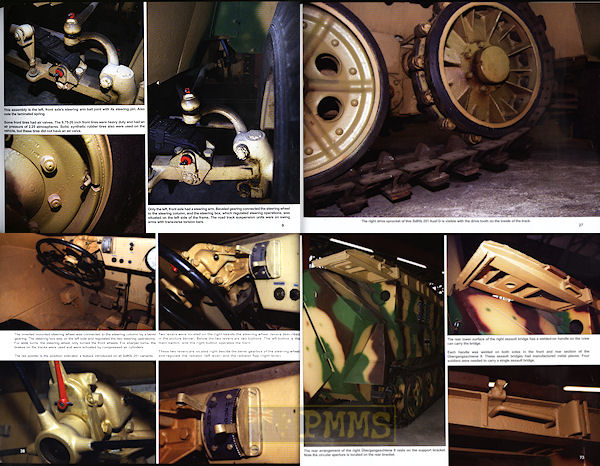
Thanks to my Credit Card for the review book.

